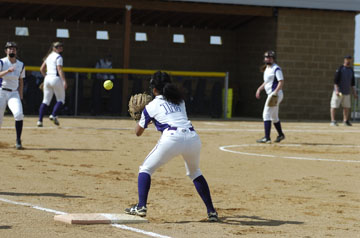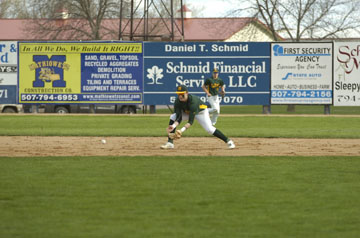Area coaches talk about the importance of defensive shifts in softball, baseball

The games of softball and baseball are constantly evolving. Both sports have put an increased role on defensive fundamentals and shifts, but at the local high school and college level, it still comes down to the basics.
While major league baseball has crazy shifts in place for every hitter that are put in place to help the team scouting against him, it really isn’t that way at the local levels. Former New Ulm Cathedral softball coach Bob Mertz is the winningest coach in state history and his method was to always focus on defense and let his assistant coaches focus on the offensive parts when at practices.
Mertz used more of the old-school method where the situation dictated where everyone was going to play and where his team was going to throw the ball in that situation. Most important, he wanted to stress that his players get the out rather than focus on how a certain hitter from another team reacts to pitches and their tendencies.
He said that his teams would always focus on defense the first two weeks of practice in the gym before they could normally get outside.
“For me, Day 1 we did a lot of taping on hitting and defense,” Mertz said. “We did a lot in the gym on, you can tell them but they need to see it. I’m not really big in scouting, you always know what’s going to happen. A runner on first base, good teams are going to bunt, they know they’re not going to score a lot of runs off us, so they’re going to try to get that one run and we’re going to try our bunt defense, we have one for a regular bunt defense and one for a slap bunter. We really spend a lot of time on defense. On Day 1, we’re doing defense right away, proper fielding, proper throwing, soft hands, quick feet. We really preach that.”

Mertz said that at the Class A level in softball, there isn’t a lot of defensive shifts like there are in Division I sports and professional sports.
“It was pretty much certain situations dictate things,” he said. “There are different philosophies on fielding, my philosophy was soft hands and bring the ball in to the body. There was a philosophy maybe 10 years ago where some said push the ball out and pick it up. I tried that at our level and they would get stiff hands and the ball would run away from them.”
Jamie Portner, Current New Ulm Cathedral softball coach
Current Cathedral head coach Jamie Portner took her team to the state tournament in her first year of coaching in 2019. The 2007 Cathedral graduate played for Mertz and she coached with him as well. She pays extra attention to social media and she will attend online meetings about the sport. She’s constantly learning about the sport and making adjustments.
“I’m part of a few Facebook groups and there’s a few about defense and hitting and stuff,” Portner said. “That’s kind of helpful because I don’t have to take off work to go to those things. I think extreme defensive shifts are harder in softball because it’s a smaller field. I think the most extreme thing we probably do is for slappers. I do a lot of stuff on Facebook and YouTube and that saves the school some money and I don’t have to take off work.”
She said she’s aware that some of the bigger schools have more shifts at their level.
“There’s stuff that even New Ulm Public does because they’re [Class] AAA and the AAAA teams, and you say ‘I would love to do that,'” Portner said. “The bigger schools have girls that specialize more so they only play one sport, even in the cities they have the complexes for year-around play that we just don’t have down here.”
Randy Cox, MLC baseball coach
Martin Luther College baseball coach Randy Cox was to have coached the Knights for his 11th season this past spring. The 2013 Upper Midwest Athletic Conference Coach of the Year said that he has plenty of technology as to where a hitter tends to hit the ball depending on where the pitch is, etc. But one thing that he always has to factor in is the weather, which plays a big part of Minnesota college baseball.
“The elements we look at is still the weather, wind conditions, like we go to Florida, fast track compared to where when you come back here it’s a slow track and it’s softer conditions,” Cox said. “So really I think the weather conditions are going to be there.
He said that it’s easier for him at the college level to use software and get information on hitters from all over the country because the technology is there. He can also add his own personal notes and make adjustments based on every at-bat that he faces them.
“What we look at, is that you can run the program and see the hitters’ tendencies, notes I can put in, with technology it’s almost like you can put in a spray chart,” Cox said. “We’ll track it manually every game and I’ll go back and look at it or I’ll have one my athletes on the bench and we’ll use that data for the next game if we see them again, or it’ll carry over to the next year when we see them. I keep all of that in a binder but it’ll change depending on which pitcher is throwing and if he can hit his spots. The positioning is still within the charts.”
He said that field surfaces are another thing to account for.
“Sometimes we’ll get an early game canceled and we’ll play it later on turf and that’s a whole different game too,” Cox said. “It’s sometimes a week-by-week preparation as to who our opponent is. It’s really the tendencies of the hitters.”
Cox said he’ll talk to his pitchers about the game plan sometimes the night before, but it’s up to the pitcher to do his job and hit his spots so the plan of attack can stay in place.
Bruce Woitas, Sleepy Eye St. Mary’s baseball
Sleepy Eye St. Mary’s baseball coach Bruce Woitas, who would have coached in his 31st season this year, has always been a defense-first coach, too. The four-time state champion coach said that he used charting a lot when he first started coaching.
“Back before we had the iPad, we always charted every hitter that we had, so if we had a tendency of a hitter to strictly pull, we might shade them,” Woitas said. “I don’t think we’ve ever shifted, shifted, we never moved someone so that we had three guys on the same side of the infield to play him to pull. I don’t think in my years at the high school level I’ve ever put three players on the same side of the field, but obviously we would make the adjustments.
“Everything is on the iPad now and that also tracks a hitter’s tendencies and you can hit something and it shows all of their at-bats,” Woitas said. “We’ve used it a little, but I don’t think we’ve overshifted.”
Like what Mertz said, Woitas said that there isn’t a lot of shifting at the Class A level, but the bigger the game, the bigger the situation is and some coaches may do what they think is necessary to attack or neutralize a hitter.
“I’d say at the playoffs you probably saw it more, but I don’t know if we saw it a whole lot,” Woitas said. “Some coaches probably did it a little bit more, others didn’t pay attention to it at all, but we’ve always charted our opposing hitters from their first varsity at-back until they were done.”



